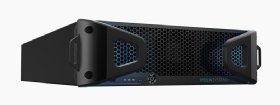
by_adr - Fotolia
Paradox: Violin Systems all-flash stays small to grow large
Violin engineers all-flash storage systems for data centers that require ultrafast performance. The vendor also added ISE G4 arrays from X-IO for secondary storage.
Violin Systems CEO Mark Lewis said thinking small is the best way for the comebacking flash array vendor to make it big.
With one full year of selling under its belt, Lewis said his strategy for future success is to walk away from the table if the deal size is too large.
"Our success depends on knowing when deals are a good fit for us. We don't have the heft to compete against the Dell EMCs or Pure Storages of the world. We're a small vendor playing in deals of a few hundred thousand dollars," Lewis said.
That means Violin Systems pitches the economics of ultrafast flash for server consolidation to midsize organizations.
"Even if you don't need your applications to run faster, there is a very powerful cost argument for lowering latency across anything that uses block storage," Lewis said.
Will those smaller deals be enough to help Violin turn a profit? Various Violin CEOs have vowed to get the vendor in the black over the years, without success. Lewis' forecast for profit is later this year or early 2020.
"It will take us some scale, but we believe it will take a very modest amount of revenue to get to profitability and cash flow," he said.

Violin extended its use case reach last November when it picked up storage assets from Axellio, formerly X-IO Technologies. Violin acquired X-IO's Intelligent Storage Element (ISE) G4 all-flash arrays from the X-IO Storage division, with an eye on secondary storage use cases.
"The G4 becomes an entry-level product for us," said Gary Lyng, chief marketing officer at Violin Systems.
The X-IO acquisition gives Violin what IDC storage research vice president Eric Burgener calls a "captive audience" of existing customers.
"That's a huge go-to-market advantage for Violin," Burgener said. "It could expand the installed base from hundreds of customers to thousands of customers in a few years."
Focus remains on extreme performance
Lewis joined Violin as a consultant after Formation Data Systems, a storage startup he founded, fell prey to a cutthroat software-defined storage market. His prior storage experience includes executive roles at Compaq, Hewlett Packard and EMC. Lewis took over as CEO in March 2018 when Ebrahim Abbasi stepped down for health reasons.
Formerly known as Violin Memory, the vendor helped pioneer the all-flash market, riding the momentum to the public markets by 2013. The original Violin Flash Storage Platform was a PCIe-based system, aimed at workloads that need higher throughput than they could get from a SCSI-based all-flash array.
Four years later, Violin was looking for a buyer, having been overtaken by array competitors with superior storage management services achieved through software. Hedge fund Quantum Partners stepped in to rescue Violin from bankruptcy in 2017.
Lewis said Violin Systems has re-established brand recognition with customers that need extreme high-performance flash. Violin sells to enterprises running scale-out transactional databases, including systems for airline reservations, high-frequency trading and inventory management.
The original Violin Flash Storage Platform's PCIe architecture paved the way for the vendor's new XVS 8 flagship, engineered from the ground up to support NVMe-oF for 32 Gbps Fibre Channel.
IDC's Burgener said the architecture Violin Systems uses should ease the transition to NVMe and NVMe-oF-.
"Building custom hardware is always a challenge. Now, Violin can use commodity off-the-shelf NVMe hardware and gain access to the latest NVMe releases. I think that gives them a real advantage in transitioning its systems to NVMe," Burgener said.





